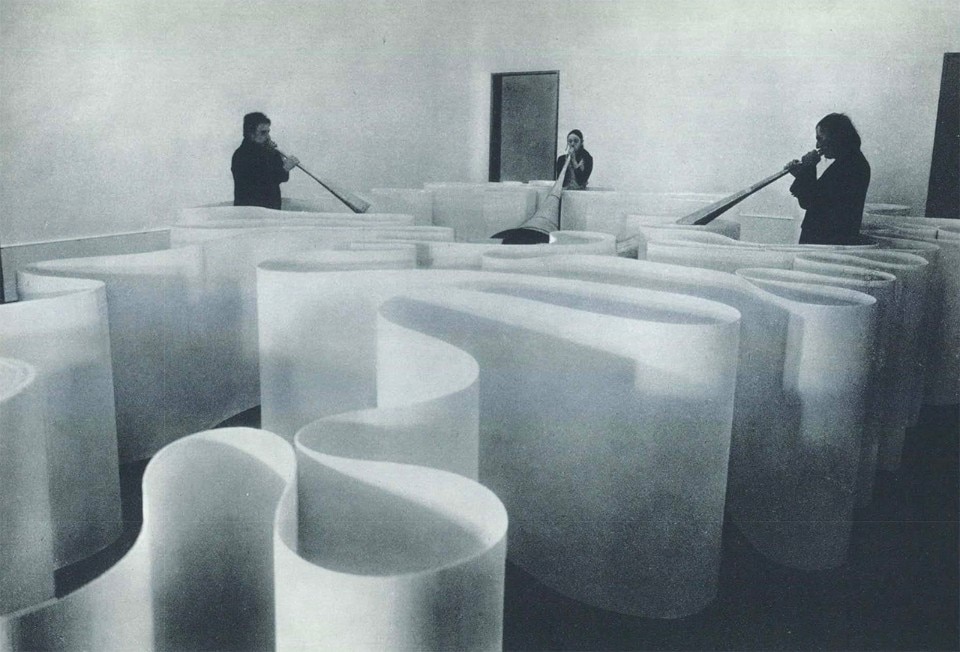The developments of the Arte Povera are strictly connected to its main promoter, Genoa-born art critic Germano Celant (1940). Celant is the author of this definition, first used for the article Arte Povera. Appunti per una guerriglia, published on Flash Art n. 5 on November 23, 1967, which brings the movement to the attention of the public. He also curates the first exhibition on the Arte Povera, Arte Povera Im-Spazio, hosted by Genoa’s Galleria La Bertesca in 1967. In the following years, Celant himself progressively fine tunes, through a sequence of exhibitions and articles, a list of the movement’s leading artists. This process results in a list of 13 names, including Giovanni Anselmo (1934), Alighiero Boetti (1940-1994), Pier Paolo Calzolari (1943), Luciano Fabro (1936-2007), Jannis Kounellis (1936-2017), Mario Merz (1925-2003), Marisa Merz (1926-2019), Giulio Paolini (1940), Pino Pascali (1935-1968), Giuseppe Penone (1947), Michelangelo Pistoletto (1933), Emilio Prini (1943-2016) and Gilberto Zorio (1944).
Arte Povera
Since 1967, Italian critic Germano Celant promotes an art movement which opposes the capitalist view of the art work as a consumption-oriented object.

The Arte Povera is commonly considered as the most relevant Italian art avant-garde of the second half of the 20th century. While it is born and defined in Italy, the movement rapidly becomes of undisputed international relevance, similarly to what happened to Futurism a few decades earlier. Several of Celant writings specifically underline a single line of evolution originating from Futurism, crossing the Italian Abstract Art from the Fifties and leading to the Arte Povera. In 1969, the exhibition When Attitude Becomes Form, organized by Harald Szeemann at Bern’s Kunsthalle, is the movement’s first major consecration outside of Italy. The Arte Povera supports a remarkable renewal and widening of the material suitable for the artistic practice: wood, metals, fabrics, and a broad selection of raw materials issued from the natural sphere, both vegetal and animal, become part of the world of art. Still this “poor” (“povero”, in Italian) matter, often inherited from local craftsmanship’s traditions, is counterbalanced by a second type of materials, industrially produced and technically advanced (mirrors, glasses, neon lights). In this respect, the duplicity of the Arte Povera echoes the dual character of Italy of that time, combining endemic misery and dazzling progress. In the wider frame of the late 1960s anti-capitalist contestation, the Arte Povera promotes a sensitivity which is in several respects antithetical to other currents such as Pop Art. It opposes both the excess of information and the dismissing of the art work as a commercial object, available for consumerism. As explained by art historian Claire Gilman, the Arte Povera doesn’t strictly identifies with an ideology, nor it devotes to actual political militancy, but it “celebrates (…) the return to nature and to body processes, as an escape route from the repressive bourgeois rationality, and from the capitalist system; [Germano Celant] belongs to the 1968 generation and his essays are imbued with that moment’s anarchical fervor”.
Michelangelo Pistoletto, 1966. From Domus 449, April 1967
Michelangelo Pistoletto, Persone di schiena, 1962. From Domus 414, May 1964
Michelangelo Pistoletto, Persone di schiena, 1962. From Domus 414, May 1964
Michelangelo Pistoletto, Persone di schiena, 1962. From Domus 414, May 1964
Michelangelo Pistoletto, Persone di schiena, 1962. From Domus 414, May 1964
Michelangelo Pistoletto, Corpo con specchio, 1966. From Domus 449, April 1967
Michelangelo Pistoletto, 1966. From Domus 449, April 1967
Pino Pascali, Bachi da setola, 1968. From Domus 462, May 1968
Jannis Kounellis, untitled, 1969. From Domus 484, March 1970
Giulio Paolini, La dea Iride, 1970. From Domus 486, May 1970
Giovanni Anselmo, Polmone per le stagioni…, detail, 1969-1970. From Domus 486, May 1970
Jannis Kounellis, 1970. From Domus 490, September 1970
Mario Merz, 1980. From Domus 610, October 1980
Mario Merz, igloo, 1984. From Domus 648, March 1984
Mario Merz, Città irreale, 1989. From Domus 711, December 1986
Mario Merz, Lance, 1966. From Domus 834, February 2001
Under the influence of this cultural environment, the Arte Povera challenges the relationship between signified and signifier. The work of art only refers to itself, and it refuses to be described through a verbal discourse, as well as to be framed in an historiography, which would inevitably reconnect it to the system from which it is trying to break free. The Arte Povera exists in the first place in the immediate gesture, its experience, and the transience of its matter. Description turns into action, and the role of the curator becomes pivotal, to the critic’s detriment. It is not by chance that one of the crucial steps of the Arte Povera’s history is the exhibition Arte Povera e Azioni Povere, which Celant is appointed to curate by Salerno-based collectors Marcello and Lia Rumma, in 1968, inside Amalfi’s ancient shipyards. In order to describe the Arte Povera’s philosophy of action, art historian Gianfranco Maraniello quotes Celant’s words, stressing the “complete osmosis of action and body, though and body, energy and individual, instantaneous consummation of the critical-aesthetic event, immediately placed beyond consumerism, and the direct shift from arte povera to azione povera”.
A common sensitivity about these and other topics defines a thread link between art works which might seem very distant at first sight, such as Pistoletto’s Quadri Specchianti, whose technique is implemented already in 1962, Mario Merz’s igloos, whose first sample dates from 1968, Boetti’s series of embroidered world maps, launched in 1971, Penone’s photographic experiments (such as the famous self-portrait Rovesciare i propri occhi, from 1970), the Bachi da setola (1968) and the several “seas” by Pascali. Celant limits the short-lived first season of the Arte Povera between 1967 and 1971, but both him and the aforementioned artists will keep its approach and goals alive in the following decades. Beyond the specificities of each one’s forms of expression, they will always share “the rejection of the systemic order, the insubordination to culture, to the hegemonic, to the image’s coding and crystallization, to the tradition of the ‘new’, to programs replicating world’s manipulation” (Maraniello).